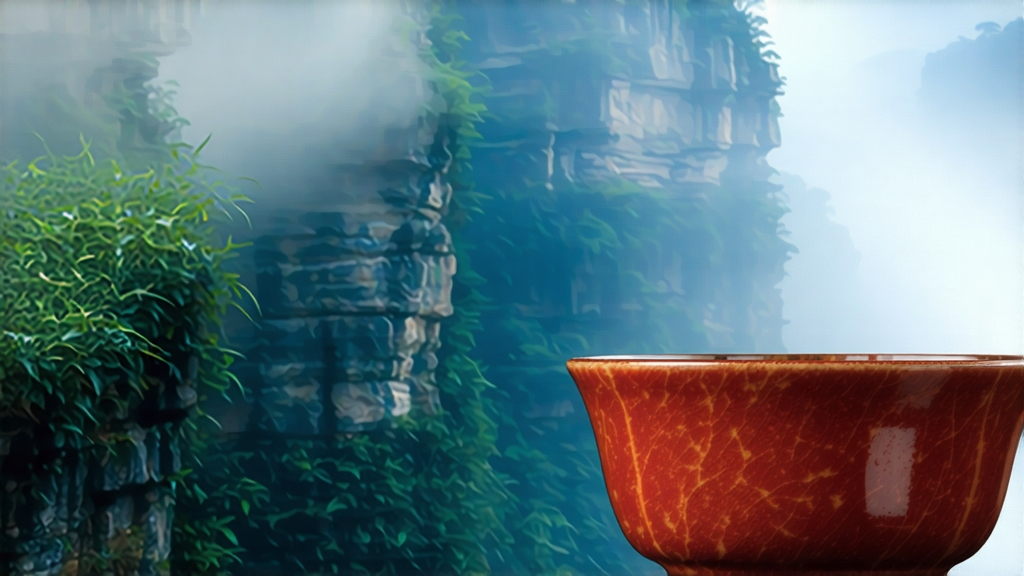
When Chinese tea lovers speak of “rock tea,” they are really speaking of a taste of stone. Nowhere is that lithic flavor more vivid than in Da Hong Pao, the legendary oolong that grows on the vertical cliffs of northern Fujian’s Wuyi Mountains. Translating literally to “Big Red Robe,” the name alone evokes imperial drama, and the tea delivers it in every sip: a dark, orchid-scented liquor that carries the cool breath of mineral gorges and the warm memory of slow charcoal embers. For centuries this cultivar has been the benchmark against which all other Chinese oolongs are measured, yet its true story is still whispered only in the dialects of local tea monks and cliff-climbing pickers.
Origin Myths and Documented History
The most romantic origin tale dates to the Ming dynasty. A Ming emperor’s mother fell gravely ill; a humble Wuyi monk presented a tea plucked from six bushes growing high on Jiulongke, “Nine-Dragon Cliff.” The empress recovered, the grateful emperor sent giant crimson silk robes to drape the bushes, and the name Da Hong Pao was sealed. While historians debate the embroidery of the story, tax records from 1655 do list “Yancha” (rock tea) as imperial tribute, and Qing-era shipping logs show Da Hong Pao exported through the port of Xiamen to eager buyers in Java and London. The original six mother bushes, now venerated and protected by the state, still cling to a cleft in the cliff; cuttings taken in the 1980s created the garden populations that supply today’s market without endangering the ancient plants.
Terroir: Why “Rock Rhyme” Matters
Wuyi’s danxia landforms—purple-red sandstone and tuff eroded into pillar-like ravines—store daytime heat and release it at night, shortening the diurnal swing and concentrating amino acids. Thin topsoil forces roots to probe fissures for moisture, absorbing calcium, potassium, and micro-nickel that translate into a pronounced mineral finish locals call yan yun, “rock rhyme.” Mist drifting from the Jiuqu (“Nine-Bend”) River keeps leaf surfaces tender, while constant trickling water amplifies humidity to 85 %, perfect for slow, fragrance-building oxidation. No other oolong terroir replicates this combination of stone, steam, and cliff-side stress, which is why Da Hong Pao is legally protected under China’s National Geographical Indication status.
Garden Genetics: Mother Trees, Clones, and Blends
Purists speak of three tiers:
- Qidan (“original bush”) tea—harvested only once a year from the six mother trees, less than 400 g total, auctioned for six-figure sums per 100 g.
- Purebred cuttings—vegetatively propagated from those bushes, now cultivated in narrow “horse-track” terraces on the same cliff face; sold as “Zhengyan” (true cliff) Da Hong Pao.
- Blended or “commodity” grade—skillful marrying of several Wuyi cultivars (often Rou Gui, Shui Xian, and Tie Luo Han) to approximate the color, aroma, and rock rhyme of the original. A master blender can achieve 80 % similarity at 5 % of the price, ensuring everyday drinkers can still taste the style.
Craft: The Choreography of Charcoal and Time
Plucking occurs in late April when leaves have reached the “medium-small open” stage, ideally on a foggy dawn to lock in aromatics. Three distinct withering phases follow: sun-withering on bamboo racks for 20 minutes, then indoor cooling on water-bleached linen, and finally a “shaking green” ritual in which 5 kg batches are tossed in a rattan drum every hour for 6–8 hours. This bruises leaf edges, initiating oxidation that travels inward until roughly 40 % of the leaf surface turns chestnut brown.
The kill-green wok is heated to 240 °C; leaves are hand-pressed for 3 minutes to arrest enzymes while preserving floral compounds. Rolling follows, first empty-barrel twisting to rupture cells, then cloth-wrapped knotting to twist leaves into the characteristic “dragonfly head, frog leg” strip shape. The decisive step is charcoal roasting: strips are loaded onto hanging bamboo sieves stacked inside a low, brick oven fueled by local hardwood embers kept